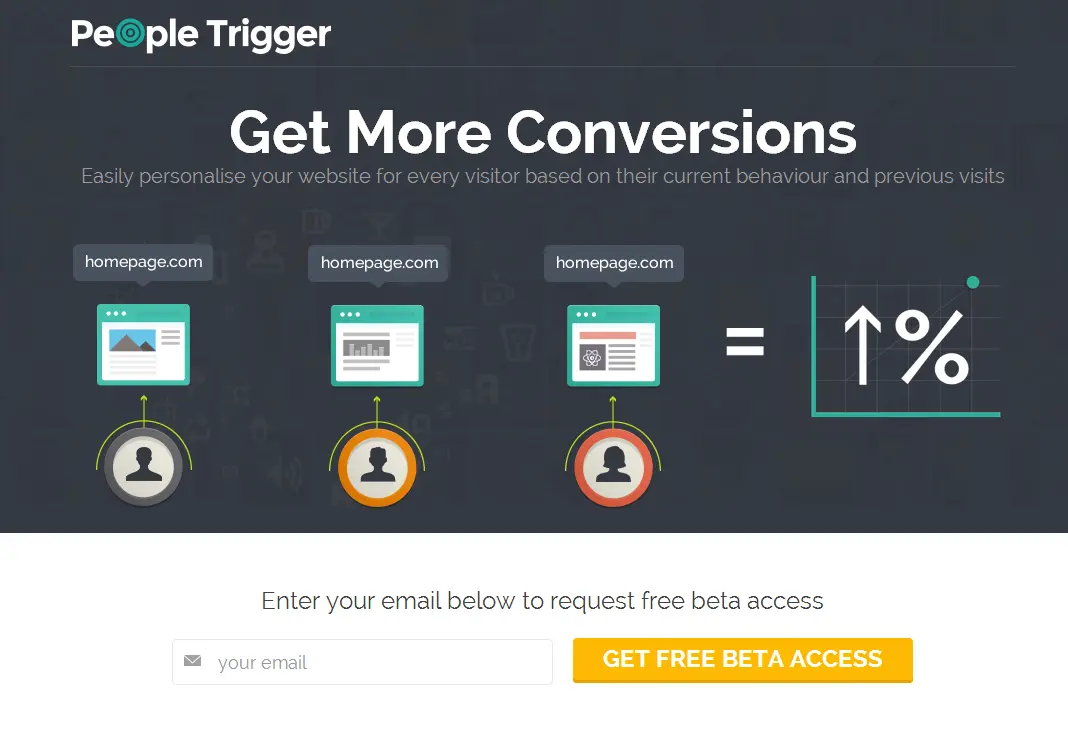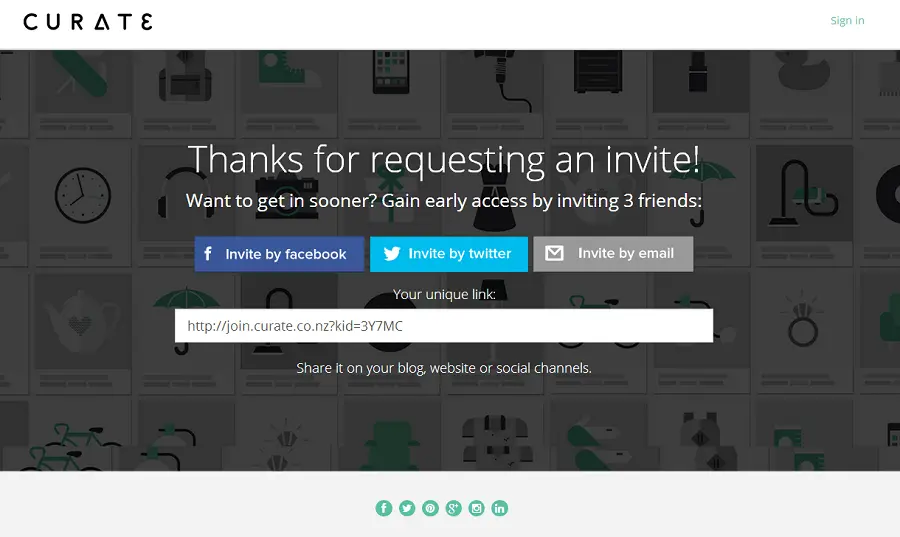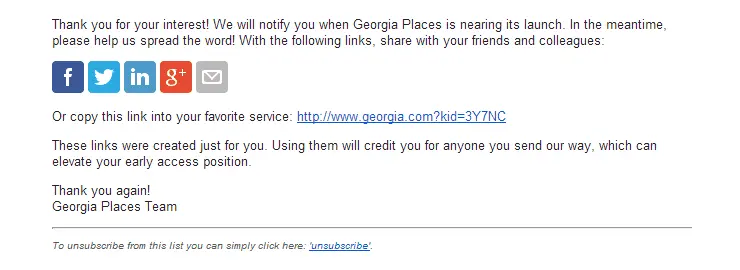
A coming soon landing page is a sign up landing page designed to generate customer leads for a product or business that does not yet exist.
A great coming soon landing page, focuses on one primary objective: getting people to sign up before launch.
Do this right and you can build enough initial brand momentum to sustain an enormous amount of signups pre-launch :)
So follow along as we go into the best practices designed to make your launch more successful…
1. Don’t skip talking to customers first

Before you buy the domain, put up the launch page, and start drafting up an employee stock option agreement; you should be sharing your idea with potential customers.
That means hitting up friends, people at coffee joints, folks off the street, etc. Following the principles of the Lean Startup of “getting out of the building” and validating your idea by talking to real people. Spend time listening to them explain the problem you are trying to solve.
Everyone you talk to should walk away knowing that you understand their pain, are committed to solving it, and are taking their ideas seriously. That’s the foundation for any great customer relationship. Ask the right questions, let them speak, and write things down.
By first talking to potential customers, you’ll be able to:
- Solve a real problem. Be sure that you’re alleviating a valid customer pain point.
- Narrow it down. Are properly defining your ideal customer segment or niche.
- Learn about your market. Gain valuable insight about who your potential customers are and how much they are willing to pay.
- Guide the initial direction of your company. Get valuable suggestions and requests. Learn what people are looking for in a product or service similar to yours.
2. The sooner you start collecting emails the better
Finding customers is a combination of art and science. It’s going to take longer than you think.
Your pitch is not as refined as the idea in your head is. You don’t really know if people want to buy that thing you’re slaving away at. Market validation is the name of the game, and collecting emails is the best way to prove there is real demand.
Timing is critical.
The sooner you publish a landing page for your product, the sooner you can:
- Refine your pitch. It takes time and tests to generate a message that strongly resonates and converts the most customers.
- Validate a product market fit. If you can’t convert people to leave their email address, you’re going to have a pretty hard time charging them money.
- Uncover distribution channels. Try directing traffic to your landing page from a number of sources and find out which source generates the most leads.
- FIND CUSTOMERS. I’ll repeat… This will take LONGER than you think. Start now or face the doom of launching to crickets… especially if this is your first new product.
3. Design your landing page around the sign up
Design, layout, copy, images, CTA’s, etc… ALL of these elements play into how well your landing page will convince people to give up their email address.
Keep the primary goal of the page in mind at all times: Getting visitors to sign up! Don’t get in the way of that.
For a well-designed, high-converting landing page, do this:
- Make the first call to action clear. The sign up area should be distinctly visible from the rest of the page. It shouldn’t blend because a user is NOT going to hunt around for it.
- Only collect the information you ABSOLUTELY need. The longer a form users see the LESS likely they are to complete it. Limit form fields by asking only for essential information. Preferably, an email address should be all you ask for.
- Include an incentive. People like to know that they are getting something out of giving up their email address. You can even use early access as an incentive for signing up.
- Use outgoing links sparingly. Anything that takes them away from the page before they have completed the goal is an unnecessary distraction. You probably have a great blog, an awesome Facebook Page, and a lot more information somewhere… but if I start clicking around I’m not going to come back to fill out the form.
- Don’t put social links on the launch page… why would people share without even knowing what they’re getting? Include these, but only after they decide to sign up.
- No 3rd party branding. Make sure that the page is about your business. Don’t allow 3rd party links to steal visitors away from your page.
- Reward sign ups with more information. Once people have signed up, you can feed them more information. The thank you message and email is where you can push them to your blog, a longer video, or to a survey you want them to fill out.
4. Tell your story
Unless you’re already an internet celebrity with a large following, you are going to have to tell people something about what you want them to sign up for.
Being stealthy only looks cool, but it generates less signups and paying customers than telling your story. Launch pages that tease customers will set you up for failure. You may have higher conversion rates… but if every signup assumes for themselves what’s being built then you’ll have a LOT of dissatisfied voices when they feel like they were misled.
NDAs just stand in the way of good conversations.
Be open, honest, and transparent with customers about what you are building. It’s better for you AND them if some people opt out, and say that what you are doing isn’t for them. That will free up your time to focus on making the people you really care about happy.
Some tips for telling a great story include:
- Make it short, sweet and tweet-able! Sorry, the internet is short attention span theater and you need to be able to fit in.
- Be honest. Let people know if this is real and being built or just something on the back of a napkin that you are testing.
- Problems are better than features. Don’t try and win a feature race before you’ve even launched. You don’t have anything built, so why would people think you’ll have everything you claim when you launch… Focus on how you are going to make their lives better.
- Add a short video and screenshot. As long as they help explain the problem being solved and tease your solution well. Shorter videos work better.
- Longer isn’t always better. Just because you can write five paragraphs addressing the problem statement doesn’t mean you should. You need only as much copy as it takes to tell a quick, yet compelling story.
- Build your buzz. Tap into your audience’s emotional triggers. Use a unique personality or humor to get the message out that your company and your offer is different.
5. Design for sharing AFTER the sign up

After someone has signed up, the goal of the page and customer interaction shifts to getting them to tell their friends about you. This is where virality can really kick in.
Take note that the best performing, virally successful launches tend to use a referral system to manage invite counts for each sign up. Where every sign up gets a unique url they can share with their friends.
Hey, guess what? KickoffLabs gives you just that. An awesome, viral referral system built-in. No coding required.
To guide and encourage people to share, do this:
- Make it easy. Have a Twitter and Facebook button front and center. These are easy wins.
- Follow up. Did you send the customer and email that explains how and why they should be sharing their unique link?
- Have a clear reward. Why should people tell their friends about you? Repeat what the incentive is, (you should have already stated it before they signed up).
- Let them know they have influence. People like knowing that other people take their advice. If someone shared your link and influenced others to sign up… tell them about it with a thank you!
6. Engage your sign ups


Once people have signed up you want to keep them interested and engaged in what you’re up to.
The rule of seven (old-school marketing concept) states that people need to hear about your product seven times before they are willing to take action.
Take this time, pre-launch, to start building up those priceless customer relationships.
Build awareness about your new company by doing this:
- Learn more about your customers. Capturing an email address gives you someone that may be willing to fill out surveys, answer questions, and give you feedback that will ultimately make your final product more successful.
- Let them in the private beta. Give private beta access to your early sign ups or the ones that have influenced the most other customers.
- Encourage more sharing. Run a contest, offer unique rewards, early access, etc to get people to share more with each interaction.
- Don’t go longer than a month without checking in. They’ll have forgotten about you and moved onto another solution. Send them information that helps them succeed today even without your product. They will be grateful for it.
- Reward people for sharing. Add in some clever copy, and even a simple “thanks” can be transformed into a worthwhile reward. People that share have automatically classified themselves as even bigger fans of what you are doing so they deserve: Extra love!
- Don’t worry about fancy designs. If you have an designer in-house, great. Though it shouldn’t be a big deal if your emails don’t resemble modern pieces of art. Plain text emails can be just as, if not more effective than their highly-designed counterparts. Focus on the message!
7. Wait until you’re ready

From our perspective, a lot of startups and new companies tend to focus too much on the product, and not enough on initial growth. This is where you can set yourself apart… By following the previous steps, you’ve kept people in the loop long enough to pique their interest.
Whether you’re going to slowly let people into the beta or will open up for everyone on a specific date: Focus on delivering what you have been promising all along.
When you’re ready for launch, be sure to:
- Deliver the goods. While you may have gone through several iterations of what the original idea was. It’s up to your company to stay true to your original message.
- Deliver on time. Develop ahead of promotion and only announce when you’re ready to launch the product or an upcoming feature. Don’t promise a date that you can’t deliver on, it will only set up your customers for disappointment.
- Remain active. A companies launch may be a one time thing, but learning about your customers should be an ongoing process. Always, always, always be talking to customers.
- ABOVE ALL, LOVE YOUR CUSTOMERS! They’re the reason you’ve successfully launched a business!
In Closing
We want your launch to be amazing, that’s why we built KickoffLabs. To help business owners and marketers do amazing things for their business.
So take what you’ve learned, go out, and launch a great company!
Oh, and be sure to tell us about it so we can share with your fellow readers…
What do you think? What else can new companies do to guarantee an awesome launch?
If you found this advice useful, let us know!
Thanks and don’t forget to share!
-Josh Ledgard, Co-Founder of KickoffLabs
Best Practices for Coming Soon Launch Landing Pages – tweet ![]()
Best practices designed to make your startup launch more successful – tweet ![]()
P.S. When you’re ready to start building more than just landing pages, and start building smarter campaigns and bigger launches. Sign up for your KickoffLabs account today!